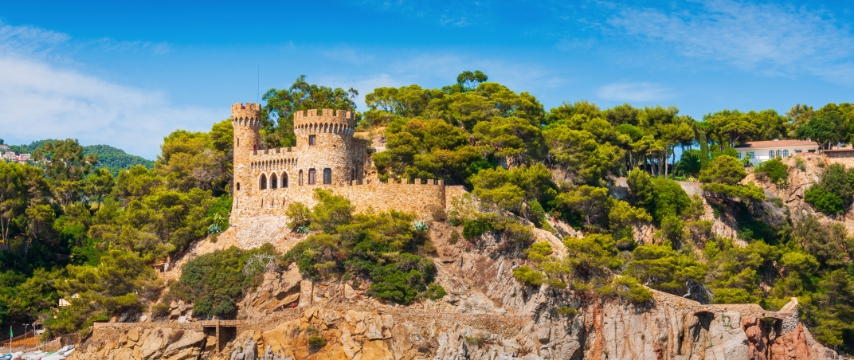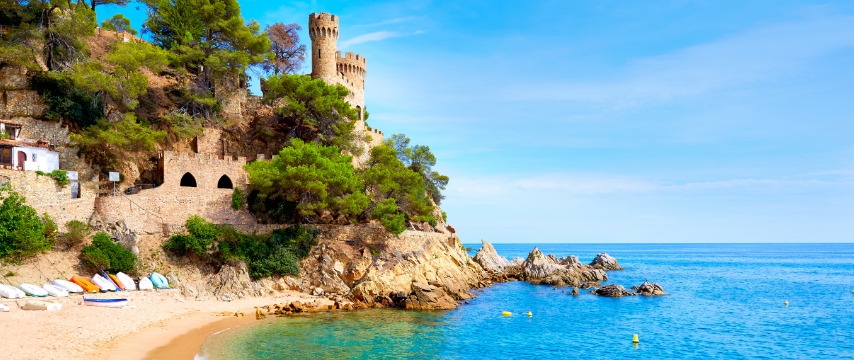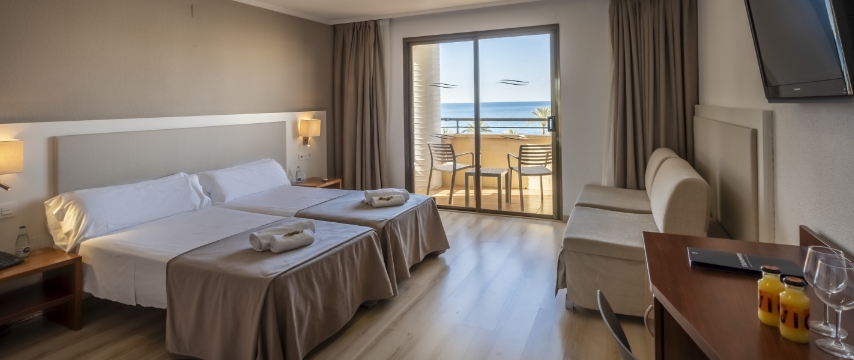

The Castle of Lloret de Mar (Castell d'en Plaja), is one of the town's most iconic symbols, a tourist landmark that stands on the rocks of Sa Caleta. If you visit Lloret de Mar, this place is a must-see to enjoy its spectacular beauty and unique setting.
The Castle of Lloret de Mar was promoted by Narcís Plaja Martí, an industrialist dedicated to the manufacture of biscuits, who commissioned the construction of this summer residence to the Girona architect Isidor Bosch. Plaja Martí's medieval appearance notwithstanding, the castle is a clear example of how contemporary architecture can pay homage to historical styles, in this case, neo-Gothic.
The project began in 1935 and the Spanish Civil War interrupted the work, which was not completed until 1940. The construction, although controversial at the time, has become consolidated as one of the emblems of Lloret de Mar, included in the Inventory of the Architectural Heritage of Catalonia and declared a Cultural Asset of Local Interestin 2021.

This castle is an impressive example of neo-Gothic architecture, with its crenellated towers, pointed arches and decorative details that reflect the grandeur of medieval castles, despite the fact that it was built with modern materials such as stone quarried from the ground itself. The building is distributed over three rectangular floors and has two circular towers, one of which is taller and slimmer than the other, giving it an asymmetrical appearance.
The castle's design reflects a strong contrast between the modern and the historical, capturing the essence of a castle that, although not from the Middle Ages, looks like something out of a fairy tale of knights and princesses. This balance between the ancient and the contemporary has made the castle blend perfectly into the landscape of the Costa Brava.
The Castle of Lloret de Mar is located at the end of Lloret de Mar's Platja Gran beach, just before reaching Sa Caleta. To get there, you can start your route from Lloret de Mar's seafront promenade and follow the Camí de Ronda in a northerly direction. This path will not only take you to the castle, but will also allow you to enjoy a coastal walk with incredible views of the sea and discover hidden coves, such as Cala dels Frares and Cala d'en Trons.
But if you prefer to drive, there are parking areas near Sa Caleta, from where you can walk to the castle in just a few minutes.

After exploring the Castle of Lloret de Mar and exploring the stunning scenery of the Lloret de Mar coastline, relax and enjoy a stay at Rosamar Hotels. Our hotels, located on the beachfront, are ideal for both families and adults looking for a place of peace and relaxation.
Hotel Rosamar Es Blau Adults Only +21 and Hotel Rosamar Maxim Adults Only +21 are ideal for relaxing with your partner. They have a spa, gym and terraces with sea views.
On the other hand, Hotel Rosamar Garden Resort, Hotel Rosamar & Spa and Hotel Rosamar Maritim are ideal for spending time with your family. They offer activities for all ages, with swimming pools, play areas and entertainment service.
Stay at Rosamar Hotels and enjoy a complete holiday, where you can combine the beauty of the Costa Brava with the comfort and wellbeing of our accommodation.

Can Font, also known as Cal Conde or Can Piuet, is a modernist-style building in Lloret de Mar built in 1877 by the Lloret-born Fèlix Torras i Mataró, commissioned by Nicolau Font i Maig. Everything you didn't know about the only Indian-style house-museum in Catalonia!
Immerse yourself in the history of Lloret de Mar by exploring the Maritime Museum - Can Garriga, Can Saragossa and the Can Font House Museum. Get ready to discover a maritime and cultural legacy that will captivate you!
Now that spring is approaching, come and discover the magic of Santa Clotilde Gardens in Lloret de Mar in their maximum splendor. An oasis of natural beauty and serenity in the heart of the Costa Brava. Discover them!
Do you want to know how the Iberians lived in Lloret de Mar? You can do it at Can Saragossa, an old farmhouse that houses permanent exhibitions on how the Iberians lived in the municipality. Discover it!
The Castle of Sant Joan is an 11th century fortification that is located on a cliff sixty meters high that separates the beaches of Lloret de Mar and Fenals, making it a magnificent space to enjoy fantastic panoramic views of Lloret de Mar.
The church of Sant Romà is one of the most representative buildings in the town. It is located in the centre of Lloret de Mar, in the Plaça de l'Església. The building is in Gothic style, but its two side chapels are in the Art Nouveau style and use the trencadís technique.